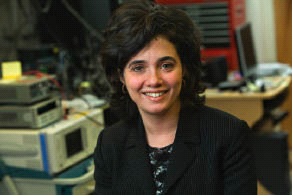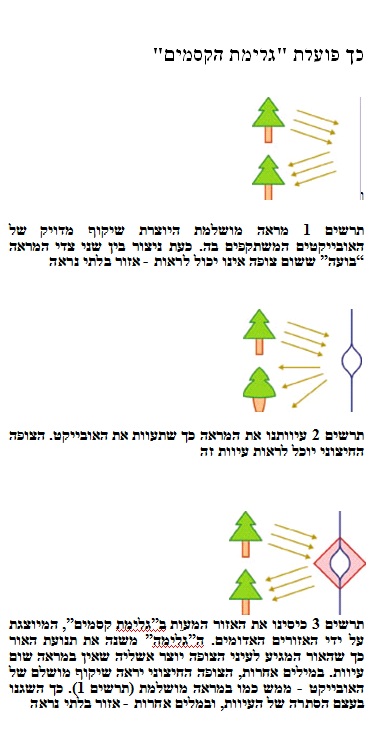The award, in the amount of half a million dollars, was given to her for her achievements in the field of silicon optics. Lipson completed her three degrees at the Technion

"The award will give me the opportunity to advance in research," says Professor Michal Lipson in a phone call from Cornell University. The tone of her voice does not indicate the size of the prize - 500,000 dollars - nor its enormous prestige. This is a MacArthur Foundation grant, known as the "Genius Award" and given to scientists, writers and people from other fields who have demonstrated extraordinary creativity and the potential for extraordinary achievements. "Lehav and Eitan, my children, are actually really excited about the award, and are more and more interested in what I do. People still tell them congratulations."
Three degrees at the Technion
Professor Lipson was born in Haifa. Her father, Professor Reuven Ofer, was a faculty member at the Faculty of Physics. When she was 8 years old, the family moved to Brazil, and only at the age of 19 did Michal return to Israel. At the Technion she did her first, second and third degrees, and within nine years, at the age of 28, she already had a doctorate in hand.
Upon completion of her doctorate, which she wrote under the guidance of Professor Elisha Cohen from the Faculty of Physics, Lipson went on to do a post-doctorate with Professor Lionel Kimmerling at MIT, and in July 2001 she arrived at Cornell, where she works as a faculty member to this day. "Michal was an excellent student," says Professor Elisha Cohen. "For me, she dealt with the optical properties of micro-resonators, and then continued to the world of silicon. Its greatness is its success in creating optical systems in silicon."
At Cornell, Professor Lipson established a research group aimed at developing optical silicon devices. The applied goal is to use light as a substitute for the electrical wires inside the microelectronic chip. "The problem with the copper wires is that they heat up and waste energy - which doesn't happen with light," she explains. "Success in the development of silicon devices that operate on light instead of metal wires will lead to a significant optimization of the chip, and therefore of the entire computer."
Silicon, traditionally, is not considered an optical medium, but Professor Lipson was able to show that "optical silicon" is within the realm of possibility. "We basically showed that it is possible to turn it into an optical material, that is, create it so that it has optical properties - and not just any optical properties, but the ones we want."
The cloak of camouflage
Another field that occupies Professor Lipson is the optical "camouflage cloak". It is a cloaking technology - hiding objects by controlling the light. "We are working on hiding curvature in the surface. Instead of the light moving in a straight line, we make it bypass the curved area, that is, go around it in a kind of Ω. In this way, this bump does not hide the light (as in normal lighting mode) and therefore it disappears from the viewer's eyes. In other words, the manipulation makes the object transparent from the viewer's point of view."
How do you do that? "We calculatedly change the refractive index of the material in certain areas of it. Basically we 'play' with the refractive index so that we get the concealment we want."
Is it possible to hide anything like this? "at the moment, no. This works fine on a small scale, but when it comes to large objects it is very complicated. Surely we can't hide people, if that's what Dunedin readers imagine."


8 תגובות
What does it help us that we gave her a doctorate and she will give the knowledge to the United States.
It reads when there is no Zionism. When education is only to succeed.
As far as I'm concerned, she's not Israeli and I'm not interested in scientific observations.
When receiving the award:
http://www.youtube.com/watch?v=OoaBxBvHuyc&feature=related
You can hear her speak here
http://www.youtube.com/watch?v=w1I8Jd6vug4
beautiful
The maiden's cloak is not something that can be worn - the technology has not reached that stage and it will take years, if at all, until it arrives.
http://www.youtube.com/watch?v=G-kQ5gCR03A
If I had a magic cloak like that, I would wear it, sneak into her room, steal half a million dollars from her and disappear with the money 🙂
mere. But what is half a million dollars? If she succeeds in developing the maiden's cloak, she becomes a billionaire at that moment.
Here is my explanation from two years ago in Maariv about the discovery of Xiang Zang and Lipson:
http://www.nrg.co.il/online/55/ART1/890/342.html
And here is a bit more detail about Lipson and Zhang's discovery from two years ago:
http://delorian64.wordpress.com/2009/05/02/%d7%9e%d7%a8%d7%91%d7%93-%d7%94%d7%a7%d7%a1%d7%9e%d7%99%d7%9d-%d7%95%d7%92%d7%9c%d7%99%d7%9e%d7%aa-%d7%94%d7%94%d7%a2%d7%9c%d7%9e%d7%95%d7%aa-%d7%a9%d7%9c-%d7%94%d7%90%d7%a8%d7%99-%d7%a4%d7%95%d7%98/
And this is Lipson's article that was published at the time (the version that can be read online):
http://arxiv.org/abs/0904.3508